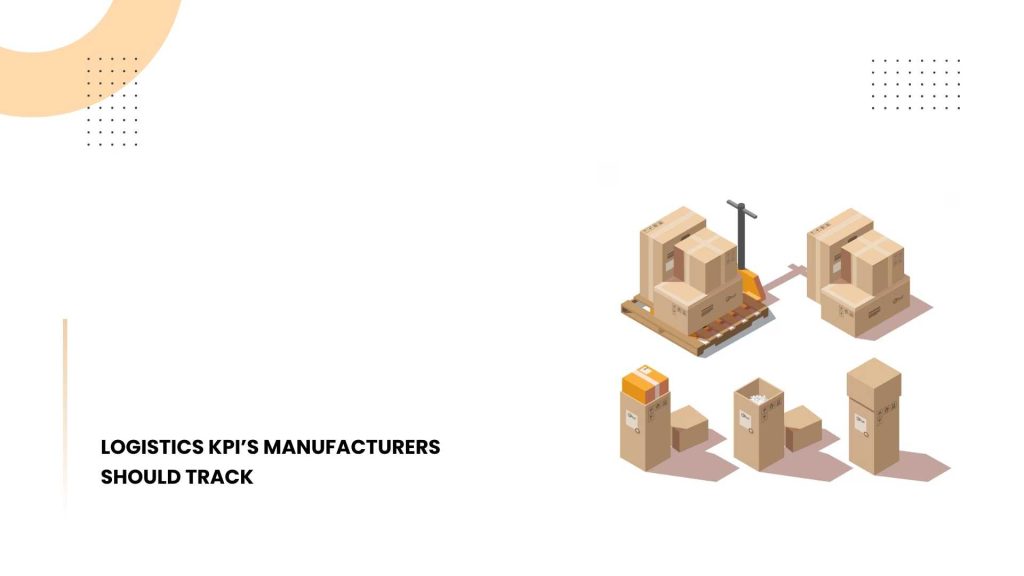In the dynamic world of manufacturing and distribution, staying ahead involves more than just delivering products. It requires precision, efficiency, and a strong emphasis on key performance indicators (KPIs) that guide the logistics process.
These metrics serve as vital signposts, directing companies toward efficient operations and enhanced customer satisfaction. Let’s delve into the important logistics KPIs that manufacturers and distributors need to track during different supply chain stages.
Inventory KPIs:
Shipping Time: The duration between order placement and product shipment. Tracking shipping time enables businesses to optimize their processes for faster delivery, reducing lead times and enhancing customer satisfaction.
Order Accuracy: The percentage of orders fulfilled accurately without errors or discrepancies. Maintaining high order accuracy minimizes returns, boosts customer trust, and reduces operational costs associated with order rectification.
Perfect Order (no issues): This holistic metric encompasses various aspects such as on-time delivery, accurate invoicing, and undamaged products. Striving for an ideal order rate enhances customer loyalty and streamlines operations by minimizing disruptions.
On-Time In-Full (OTIF): Measures the percentage of orders delivered complete and on schedule. High OTIF rates indicate efficient logistics operations, reducing stock outs and backorders while optimizing inventory management.
Number of Shipments: Tracks the volume of shipments processed within a specific timeframe. Monitoring shipment frequency aids in assessing workload distribution, optimizing route planning, and identifying opportunities for consolidation to reduce costs.
Distribution KPIs:
Lead Time: The duration between order placement and delivery to the customer. Shorter lead times enhance responsiveness and agility in meeting customer demands, contributing to competitive advantage and customer satisfaction.
Capacity Utilization: Evaluate how distribution resources (e.g., warehouse space and equipment) are utilized efficiently. Maximizing capacity utilization minimizes idle resources and optimizes storage and handling costs.
Productivity: Estimates the output developed per unit of resource input (e.g., labor hours, equipment usage). Improving productivity within distribution centers enhances throughput, reduces operational costs, and supports scalability.
Order Management KPIs:
Customer Backorder Rate: Indicates the percentage of customer orders that cannot be fulfilled immediately due to insufficient inventory. Managing backorder rates efficiently mitigates stockouts, maintains customer satisfaction, and informs inventory replenishment strategies.
Inventory Accuracy: Measures the precision of inventory records compared to physical inventory counts. Proper inventory data decreases the risk of stockouts, overstocking, and order discrepancies, enabling better decision-making and resource allocation.
Inventory Turnover: Calculates the rate at which inventory is replenished or sold within a specific period. High inventory turnover signifies efficient inventory management, minimizing carrying costs, and optimizing working capital utilization.
Supply Management KPIs:
Vehicle/Trailer Utilization Rate: Assesses the efficiency of transportation assets by measuring the time they are actively utilized for freight movement. Maximizing utilization rates optimizes asset utilization and reduces per-unit transportation costs.
Warehousing Costs: Tracks the expenses associated with storing and handling warehouse inventory. Monitoring warehousing costs aids in identifying cost-saving opportunities, optimizing storage space utilization, and enhancing overall supply chain efficiency.
Average Dwell Time: Measures shipments spent within a warehouse or distribution center before being processed or dispatched. Minimizing dwell time enhances operational agility, reduces inventory holding costs, and improves supply chain responsiveness.
Transport Management KPIs:
Delivery Time: Measures the time to deliver shipments from origin to destination. Monitoring delivery time enables businesses to identify bottlenecks, optimize route planning, and enhance customer satisfaction through timely deliveries.
Average Days Late: Tracks the average delay in fulfilling customer orders beyond the promised delivery date. Minimizing average days late reduces the risk of customer dissatisfaction, penalties, and operational disruptions.
Truck Turning: Evaluates the efficiency of truck loading and unloading processes, measuring the time vehicles spend at facilities for these activities. Optimizing truck turning times minimizes driver wait times, enhances fleet productivity, and reduces transportation costs.
Freight Payment Accuracy: Ensures the accuracy of freight billing and payment processes, minimizing errors and discrepancies in transportation invoices. Improving payment accuracy enhances financial transparency, reduces disputes, and fosters stronger vendor relationships.
Transportation Costs: Tracks the expenses of transporting goods from suppliers to customers. Monitoring transportation costs enables businesses to identify cost-saving opportunities, optimize carrier selection, and negotiate favorable freight rates.
Conclusion
Acumatica Distribution Management Edition offers a complete solution to optimize their logistics operations. Integrating these critical functions with financial and sales data enables organizations to enhance efficiency, reduce costs, and improve decision-making processes.
With its robust features and user-friendly interface, Acumatica facilitates streamlined workflows and fosters greater collaboration across departments, ultimately driving sustainable growth and success in today’s dynamic business landscape.

Vijay comes with a vast experience in ERP and enterprise solutions space with about 20 years of experience in various packaged application like Acumatica, SAP, Orion, Salesforce.com, SugarCRM and, SalesLogix.

